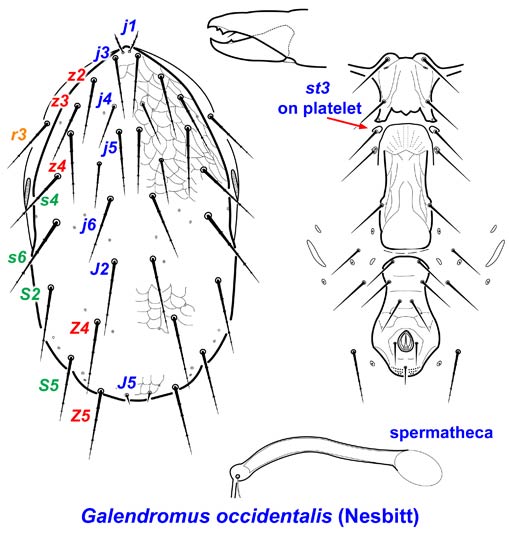Taxonomic Position
Cohort Gamasina
Subcohort Dermanyssiae
Superfamily Phytoseioidea
Family Phytoseiidae Berlese
Subfamily Typhlodrominae Chant & McMurtry
Galendromus (Galendromus) Muma
(syn. = Metaseiulus, Typhlodromus in part)
Diagnostic characters: Typhlodrominae, Metaseiulini (setae s6 present; z3 usually present; z6, S4 and JV4 absent) with:
-
s6, J2, S2, S5, JV2-3 present (+ normally present setae r3, s4, j4-6, Z4-5, J5, JV1, JV5, ZV1-2)
-
z6, J1, Z1, Z3, S4 , R1, JV4 absent

-
z3, ZV3 present or absent
-
when present, base of z3 +/- aligned with and equidistant from bases z2-4
-
j3 inserted near base of j1
-
legs without macrosetae
-
calyx of spermatheca elongate, tubular
Similar taxa. Phytoseiinae lack setae Z1, S2, S4 and S5. Amblyseiinae lack both setae z3 and s6. Ascids usually have dorsal shields with 22 or more pairs of setae and only rarely (e.g. Blattisocius) have phytoseioid-like corniculi. Within the Metaseiulini only Galendromus have setae R1 absent and S2 present; Galendromus (Mugidromus) species have shorter dorsal setae and setae j3 inserted well behind setae j1.
Ecology & Distribution. Species of Galendromus are found primarily in Central America and the southern United States, but species used in biological control of spider mites (e.g. G. occidentalis) have been introduced around the world.
References
Chant DA. & McMurtry JA. 1994. A review of the subfamilies Phytoseiinae and Typhlodrominae (Acari: Phytoseiidae). International Journal of Acarology 20: 223-310.
Denmark, H. A. 1982. Revision of Galendromus Muma, 1961 (Acarina: Phytoseiidae). International Journal of Acarology 8 : 133-167.
Schicha e.
1987. Phytoseiidae of
Australia and Neighbouring Areas. (Indira Publishing House, Oak Park, Michigan, USA.)
Schuster RO & Pritchard EA. 1963. Phytoseiid mites of California. Hilgardia 43: 191-285.